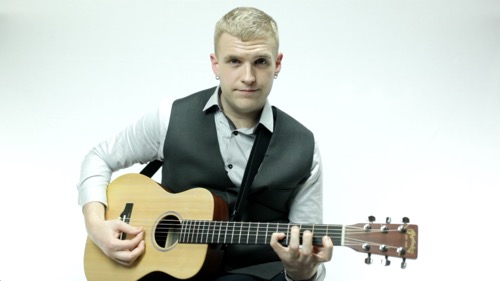大调音阶中的音程

Hi. This is Hub Guitar.
We're going to look at all of the notes in the major scale, and think of them in terms of their distance from the root of the scale. We'll do this in C, but it works in every key of course.
If you play two C's of the same exact type, that's called a unison.
From the first note of the scale to its second, we have a major second. That makes sense. It's the second note of the scale, and it's a major scale.
From the first note to the third we have a major third. That makes sense too.
From the first note to the fourth is a perfect fourth. This interval exists in most scales, whether major or minor, so it's called a perfect fourth.
From the first note to the fifth is a perfect fifth. Just like the perfect fourth, almost every scale has this same interval.
From the first note to the sixth is the major sixth.
From the first note to the seventh is the major seventh.
And finally from the first C to another C is an octave. It's the same note but it vibrates at twice the frequency so it sounds higher.
Once you've become familiar with these, you can start to recognize intervals by thinking of the lower note as being the root note of a major scale.
Let's try some practice. One thing you can do is just find any two notes on the guitar and try to quiz yourself and figure out what are those two notes. You want to think of the lower note as the root of the scale, and ask yourself in that major scale that would be built from the lower note, what role would the higher note play? In this case we have a major fifth. So if you can learn to recognize those by ear, find them on the guitar, all of the intervals that exist from the root to another note of a major scale, and then find random intervals and try to figure out what they are. That'll really help you so that when you are learning songs by ear, you can figure out what all the notes are and then you maybe don't need to go online and download tabs anymore.
什么是音程?
音程就是两个音之间的高低关系。举例来说,音程可以最小为0(两个音是同度unisonTwo notes of exactly the same pitch; for instance, two “C” notes. It is not possible to play a unison on a standard piano. On a guitar it is possible using two strings.),或最大到12(一个八度octaveAn interval of twelve semitones. Octaves are very important in music theory.)。音阶中的根音和其他任何音符构成音程,这样我们可以找到许多不同的音程,比如说,2个半音semitoneThe smallest possible distance between two pitches, also called a half step or minor second.s的距离叫做大二度(major second),大调音阶的“C” 和 “D”就是。但是一个半音的距离,就叫做小二度(minor second),“E” 到 “F”,但是以大调音阶的“C”出发的话,我们找不到小二度。
学习去聆听,弹奏和唱出所有的音程,会对你在很多方面有帮助,比如写歌,即兴演奏。
现在我们要开始学习大调音阶中所有音程的名称,以根音作为音程的第一个音符。
我们先来弹奏一下一个八度的C大调音阶,从C到C。
边弹边唱出音名,我们会用唱名(solfege)唱出音阶中的音符。其实你以前一定就听到过了,有一首歌叫“Do Re Mi”,开头是这样的:“Doe / a deer / a female deer.”
大调音阶音程表
| C | D | E | F | G | A | B | C |
| do | re | mi | fa | so | la | ti | do |
| unison | major 2nd | major 3rd | perfect 4th | perfect 5th | major 6th | major 7th | octave |
在上一次音程的课程,我们已经讨论过音程是由哪两部分构成:第一个是数字,表示到根音的距离,第二个是属性,是大音程,小音程,还是纯音程等等。大调音阶里,只有大音程或纯音程,而这也是为什么这些音程被叫做“大音程”—的原因。两个半音的距离叫做大二度(major second),因为如果较低的音符是大调音阶的根音的话,较高的音就是大调音阶的第二个音,叫大二度。
怎么记住音程
大二度
Do到Re … 是大调音阶中的第一个音程,它是大二度(major second)。一般在歌曲的开头出现,比如“Happy Birthday”中,‘happy’和‘birth’就是大二度音程。
大三度
Do到Mi …这个音程是大三度(major third),你可以在歌曲“Oh When the Saints Go Marching In,”里的‘oh’和‘when’之间听到。
纯四度
Do到Fa …这个音程叫做纯四度(perfect fourth),比如,Bridal Chorus的第一第二个音(“Here Comes The Bride”),也就是‘here’ 和 ‘comes’就是。
纯五度
Do到So …是纯五度(perfect fifth),在歌曲Star Wars theme的开头可以听到。
大六度
Do到La …是大六度(major sixth),可以在Star Wars的一首歌Leia’s Theme里听到,还有歌曲“Somewhere Over The Rainbow”里的‘way’ 和 ‘up’。
大七度
Do到Ti … 这个音程不是很常见,它叫做大七度(major seventh),可在Willy Wonka的歌“Pure Imagination”中‘in’ (a) ‘world’听到。
八度
Do到Do …是八度(octave),“Somewhere Over the Rainbow.”的开头就是八度音程。
音程其他的记忆方法
歌曲“Somewhere Over the Rainbow”中用到了大调音阶的所有音程,试试找到它们,写下来,然后自己弹奏一下。
小练习
- 以“小和弦”和旋律的形式,在你的吉他上练习音程。
- 唱出音程。
- 在吉他上弹奏一个音,你可以唱出以这个音为根音的大调音阶吗?
- 在吉他上弹奏一个音,你可以唱出这个音的纯五度音程吗?
- 如果你没听过上面的例子中说到的歌曲,你可以在其他歌曲中找到相对应的音程吗?
 As the creator of Hub Guitar, Grey has compiled hundreds of guitar lessons, written several books, and filmed hundreds of video lessons. He teaches private lessons in his Boston studio, as well as via video chat through TakeLessons.
As the creator of Hub Guitar, Grey has compiled hundreds of guitar lessons, written several books, and filmed hundreds of video lessons. He teaches private lessons in his Boston studio, as well as via video chat through TakeLessons.